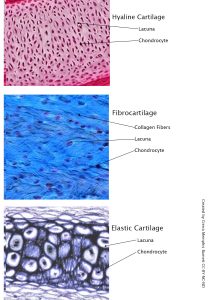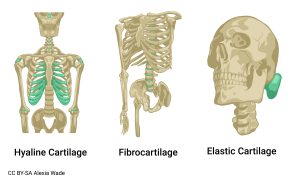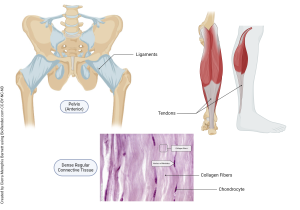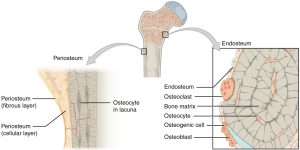Cartilage and Dense Connective Tissue
Objective 9.4
9.4.1 Identify and describe the cartilaginous components of the skeletal system.
9.4.2 Describe the roles of dense regular and dense irregular connective tissues in the skeletal system.
The skeletal system is not all compact bone and spongy bone. It contains a lot of cartilage and also dense connective tissue. Let’s look at where these are found and what they do.
Cartilage
 Much of the skeleton is made up of cartilage, which is much softer and more pliable than bone. Cartilage is very important at locations where one bone contacts another (joints), whether those joints move or not.
Much of the skeleton is made up of cartilage, which is much softer and more pliable than bone. Cartilage is very important at locations where one bone contacts another (joints), whether those joints move or not.
Hyaline cartilage (Greek υαλος, ialos, glassy) gets its name from its resemblance to glass — shiny and translucent. Hyaline cartilage has a great deal of organic ground substance with no apparent structure.
The chondrocytes that produce cartilage are found in little spaces called lacunae amongst the glassy ground substance (just like osteocytes are found in lacunae in bone). Most cartilage in the body is hyaline cartilage.
Fibrocartilage, is, of course, more fibrous in appearance and structure. As with hyaline cartilage (and bone), chondrocytes are found in lacunae. In fibrocartilage, however, the ground substance has lots of collagen fibers running through it. Fibrocartilage is found in the intervertebral discs, in the pubic symphysis (where the right and left halves of the pelvis are joined), and in the menisci of joints.
Elastic cartilage has a structure very similar to fibrocartilage, except that it has elastin fibers instead of collagen fibers. Elastic cartilage is found in the ear and epiglottis, two structures that need to be strong, but also flexible, so they snap back into shape when moved and released.

Dense Connective Tissue
We can find both dense regular and dense irregular connective tissue in the skeletal system. Remember, the difference between the two is the orientation of the fibers. Dense regular connective tissue, with all the fibers running parallel to one another, is found in both tendons and ligaments. Tendons connect muscle to bone (more about tendons in Unit 10). Ligaments are band-like structures that strap one bone to another. The parallel orientation of collagen fibers gives tendons and ligaments significant strength in one direction, as well as a striated appearance in gross anatomical specimens.

A very important dense irregular connective tissue (fibers not all running parallel) of the skeletal system is the periosteum, (Greek περι, peri-, surrounding, + -osteum) a thin membrane that surrounds all bones. The non-parallel orientation of collagen fibers gives this tissue a lot of strength in multiple directions. If you are a carnivore, you may have encountered periosteum as the paper-like membrane on the bone surface of barbequed ribs. The periosteum has a rich blood supply and lots of free nerve endings; it is the source of both swelling and pain when you break a bone (or bruise the periosteum). Periosteum is also what connects tendons to bones, as well as ligaments to bones, and is very important in bone repair and remodeling (as we’ll see a couple of objectives later). Dense irregular connective tissue also makes up the endosteum, the thin layer that lines the medullary cavity (on the surface of trabeculae).

Media Attributions
- U09-011 U09-012 Cartilage © Barnett, Cierra Memphis is licensed under a CC BY-NC-ND (Attribution NonCommercial NoDerivatives) license
- U09-013 alexia wade © Wade, Alexia is licensed under a CC BY-SA (Attribution ShareAlike) license
- U09-014 U09-015 U09-016 Dense Regular Connective Tissue © Barnett, Cierra Memphis is licensed under a CC BY-NC-ND (Attribution NonCommercial NoDerivatives) license
- Periosteum and Endosteum © Betts, J. Gordon; Young, Kelly A.; Wise, James A.; Johnson, Eddie; Poe, Brandon; Kruse, Dean H. Korol, Oksana; Johnson, Jody E.; Womble, Mark & DeSaix, Peter is licensed under a CC BY (Attribution) license

